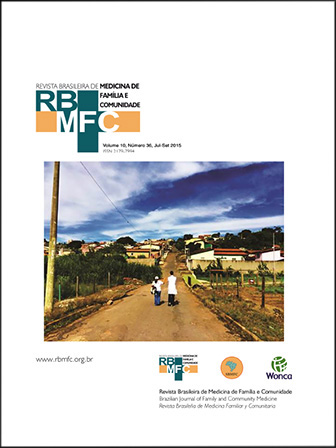Puerperal women’s knowledge on the identification and prevention of loxoscelic acidentes
DOI:
https://doi.org/10.5712/rbmfc10(36)778Keywords:
Arachnidism, Insect Bites and Stings, Public Health, Accident Prevention, Health EducationAbstract
Objectives: this study aimed to identify puerperal women’s level of knowledge about the Loxosceles spider, its bite, and their own conduct in the event of a loxoscelic accident involving them or their children. Methods: this was a quantitative cross-sectional study using a structured questionnaire that included the socioeconomic profile of the participants, and knowledge about the brown spider and loxoscelism. Participants included postpartum women (between the first to tenth day of delivery), admitted to the maternity ward of the Hospital do Trabalhador, Curitiba-PR, between July and October 2011. From a total of 208 postpartum women, eight were excluded because the questionnaires were filled incorrectly. Data were tabulated using Microsoft Excel 2007® and analyzed using the χ2 test and Fisher’s exact test. Results: regarding the knowledge about the spider, 61% of the participants said that they knew the spider and identified the correct picture. About their conduct in case of loxoscelic accidents, 87.5% gave appropriate responses, but only 37% identified the correct symptoms. Hypothesis testing revealed that age, education, and prior experience of loxoscelic accidents were directly proportional to the participants’ knowledge (p<0.05). Conclusion: most of the women surveyed could identify the brown spider and largely recognized the spider’s bite injury, but they overestimated its severity. On the contrary, they had little knowledge about the symptoms, which may lead to delayed treatment for them or their children. The participants’ knowledge about the spider was directly related to age, education, and prior experience of a loxoscelic accident.
Downloads
Metrics
References
Guimarães AB. Análise peptidômica comparativa das peçonhas de duas espécies de aranha marrom: Loxosceles laeta e Loxosceles intermedia [Dissertação de mestrado]. Brasília: Universidade de Brasília, Instituto de Química, Programa de Pós-Graduação; 2009. Disponível em: http://repositorio.bce.unb.br/bitstream/10482/8874/1/2009_AlineBarbosaGuimaraes.pdf
Silva EM. Loxoscelismo no estado do Paraná: análise epidemiológica dos acidentes causados por Loxosceles Heinecken & Lowe, 1832 no período de 1993 a 2000 [Dissertação de mestrado]. Rio de Janeiro: Fundação Oswaldo Cruz, Escola Nacional de Saúde Pública; 2002. Disponível em: http://www.saude.pr.gov.br/arquivos/File/zoonoses_intoxicacoes/anim_pec/Loxoscelismo_no_Pr.pdf
Juckett G. Arthropod bites. Am Fam Physician. 2013;88(12):841-7. PMID: 24364549
Brasil. Ministério da Saúde. Acidentes por animais peçonhentos - Aranhas - Informações Técnicas. Disponível em: http://portal.saude.gov.br/portal/saude/profissional/visualizar_texto.cfm?idtxt=39277
Silva EM, Souza Santos R, Fischer ML, Rubio GBG. Loxosceles spider bites in the state of Paraná, Brazil: 1993-2000. J Venom Anim Toxins Incl Trop Dis. 2006;12(1):110-23. DOI: http://dx.doi.org/10.1590/S1678-91992006000100009
Pinto LR, Mendonça F, Araujo WM. A influência das variações térmicas nos acidentes loxoscélicos em Curitiba/PR. Rev Bras Climatol. 2009;5:55-69.
Vetorello ML. A influência da temperatura, umidade relativa do ar e radiação solar na incidência dos acidentes loxoscélicos em Curitiba, Paraná, Brasil, no período de 1998 a 2001 [Dissertação de especialização]. Curitiba: Universidade Federal do Paraná, Setor de Ciências Biológicas, Departamento de Patologia; 2002.
Pinto LR. Loxoscelismo em Curitiba: uma abordagem geográfica [Dissertação de mestrado]. Curitiba: Universidade Federal do Paraná, Setor de Ciências da Terra, Departamento de Geografia; 2009.
Brasil. Secretaria Municipal de Saúde de Curitiba. Acidentes loxoscélicos - protocolo técnico e fluxo de atenção em Curitiba. Curitiba: Secretaria Municipal de Saúde; 2006 [Acesso 16 Ago 2015]. Disponível em: http://www.saude.curitiba.pr.gov.br/images/institucional/arquivos/protocolos/protocolo_001.pdf
Trentini RP. Histórico do loxoscelismo e sua ocorrência no município de Curitiba - Paraná [Dissertação de especialização]. Curitiba: Universidade Federal do Paraná, Setor de Ciências da Terra, Programa de pós-graduação; 2002.
Gehrie EA, Nian H, Young PP. Brown Recluse spider bite mediated hemolysis: clinical features, a possible role for complement inhibitor therapy, and reduced RBC surface glycophorin A as a potential biomarker of venom exposure. PLoS One. 2013;8(9):e76558. Disponível em: http://dx.doi.org/10.1371/journal.pone.0076558
Tambourgi DV, Gonçalves-de-Andrade RM, van den Berg CW. Loxoscelism: From basic research to the proposal of new therapies. Toxicon. 2010;56(7):1113-9. DOI: http://dx.doi.org/10.1016/j.toxicon.2010.01.021
Rader RK, Stoecker WV, Malters JM, Marr MT, Dyer JA. Seasonality of brown recluse populations is reflected by numbers of brown recluse envenomations. Toxicon. 2012;60(1):1-3. DOI: http://dx.doi.org/10.1016/j.toxicon.2012.03.012
Buss PM. Promoção da saúde e qualidade de vida. Ciênc Saúde Colet. 2000;5(1):163-77. DOI: http://dx.doi.org/10.1590/S1413-81232000000100014
Brasil. Ministério da Saúde, Fundação Nacional de Saúde. Manual de diagnóstico e tratamento de acidentes por animais peçonhentos. 2a ed. Brasília: Ministério da Saúde; 2001.
Downloads
Published
How to Cite
Issue
Section
License
By submitting a manuscript to the RBMFC, authors retain ownership of the copyright in the article, and authorize RBMFC to publish that manuscript under the Creative Commons Attribution 4.0 license and identify itself as the vehicle of its original publication.















